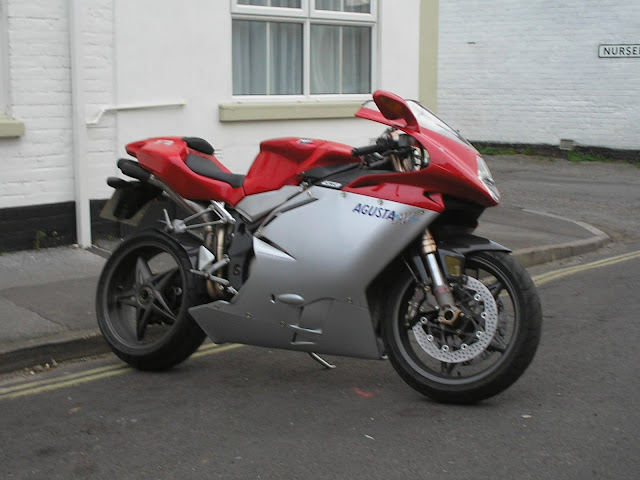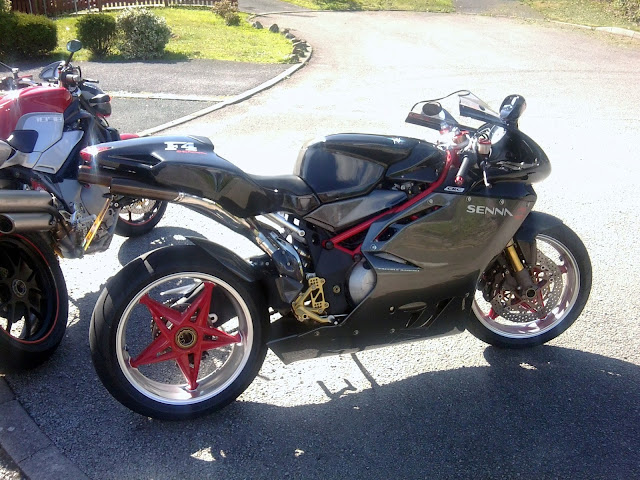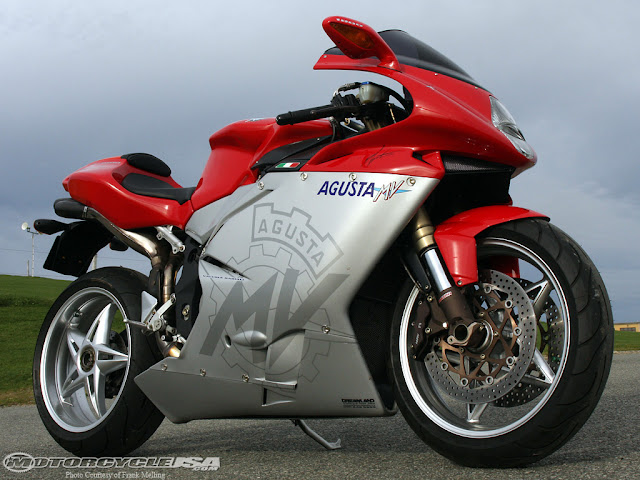MV Agusta 750 F4
The F4Is quartet <>' high-level silencers gave a unique rear view. Exhaust and intake notes were tuned for rider enjoyment as well as performance.
Indisputably one of the world’s most stylish superbikes, the F4 echoed the mighty MVs of the past with its red and silver paint scheme and Jour-cylinder engine layout.
If ever there was a bike that epitomized the Italian love of glamour, speed and all things mechanical it was the 750 F4 with which MV Agusta was reborn in 1999. The F4 was gorgeous and brilliantly engineered, from the tiny twin headlights in its fairing’s nose all the way to the four cigar-shaped tailpipes that emerged from beneath its sculpted tailpiece. It had performance, handling, and a fascinating history. MV Agusta, one of the world’s most famous marques, was back - in style.
The old MV firm from Gallarate, north of Milan, had won 17 consecutive 500cc world championships and built some of the world’s fastest and most exotic roadgoing superbikes before production ended in the early 1980s. The marque appeared dead until revived by Cagiva boss Claudio Castiglioni. After almost a decade of intermittent development, design genius Massimo Tamburini completed a bike to rank with the mighty Ducati 916, his previous creation.
The F4's innovative chassis combined a ladderlike tubular steel main frame with cast swingarm pivots. On the limited-edition Serie Oro (Gold Series) F4, of which only 300 units were built, these cast parts were made from magnesium instead of the aluminium used for the mass-produced F4 S. The forks, especially developed by Japanese specialist Showa, were of an unprecedented 49mm diameter. The six-piston brake calipers were developed with Nissin: the tyres specially created by Pirelli. Tamburini's Cagiva Research Centre (CRC) designed the bodywork, which was made from lightweight carbon-fibre.
Ferrari engineers collaborated in the early design of the F4's 749cc engine, a liquid-cooled, 16-valve inline four that differed from Japanese rivals by having radial valves, which MV's engineers said gave better breathing. The F4 was also the only roadgoing bike to have a racebike- style removable ‘cassette’ gearbox. Tamburini designed the complex exhaust system after dismantling and studying the exhaust of Castiglioni's Ferrari F40.
Glorious exhaust note
The fuel-injected motor's peak output was 126bhp, so the 750cc F4 did not match open-class superbikes for outright speed. But the bike revved to 13,300rpm, made an improbably glorious exhaust note, and was seriously fast. The four- cylinder unit was smooth and sophisticated, too.
It pulled crisply at low revs, and its six-speed gearbox was slick. There was no great step to the power delivery, just a steady increase as the yellow-faced rev-counter’s needle swept round the dial and the F4 headed for its top speed of over 160mph (257km/h).
Handling was superb. At 4061b (184kg) dry the Serie Oro was very light. Its short wheelbase and racy steering geometry combined with the top- quality frame and suspension to make the bike wonderfully agile yet also very stable. At high speed in a straight line the bike was unshakeable, yet it could also be snapped into slow turns with the lightest of pressure, and was easy to flick from side to side. The brakes were very powerful, too. needing just a gentle squeeze of the lever to make the bike stop w ith massive force.
For all its stunning looks and innovative technolog . some cynics argued that the F4. even the ultra-expensive Serie Oro version, was no lighter or more powerful than Suzuki"s much cheaper GSX-R750. But to assess the F4 in such terms was to miss the point - this was a bike that was one of the most stylish and immaculately detailed ever built, as well as one that will be forever remembered as the machine with which one of the great marques n. For the all-new F4 to be so beautiful, so fast and very special was an achievement t long and glorious history M\ Ae o.
MV Agusta's enviable reputation was forged by the marque's 38 grandprix championships, including 18 in the 500cc class, and by fire-breathing four- cylinder superbikes of the 1970s.
The first 300 F4s were in exotic Serie Oro specification, with magnesium swingarm, frame castings and wheels, where the mass-produced F4 S used aluminium.
Straight-line performance of the 749cc F4 could not quite match that of open-class sports machines, but the F4's stability and handling poise were exceptional.
Specification MV Agusta 750 F4 Serie Oro (1999)
- Engine Liquid-cooled dohc 16-valve four
- Capacity 749cc (73.8 x 43.8mm)
- Maximum power 126bhp @ 12,500rpm
- Transmission Six-speed, chain final drive
- Frame Tubular steel and cast magnesium
- Suspension Telescopic front; single shock rear
- Brakes Twin discs front; disc rear
- Weight 406lb (184kg)
- Top speed 165mph (266km/h)
























0 comments: